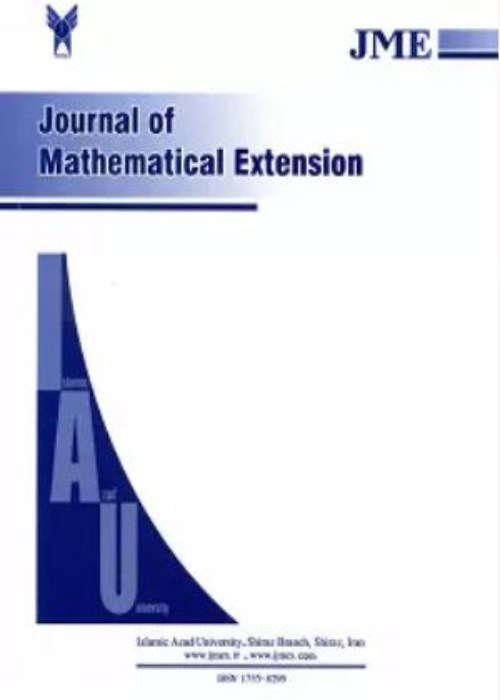فهرست مطالب

Journal of Mathematical Extension
Volume:17 Issue: 6, Jun 2023
- تاریخ انتشار: 1402/05/01
- تعداد عناوین: 6
-
-
Page 1
In this paper, we prove that a faster iterative algorithm can be used to reach the solution of the Volterra functional integral equation of the second kind. Also, we show that a data dependence result can be obtained for this integral equation and to support this result we give an example.
Keywords: Iterative algorithm, contraction principle, volterra integral equation, convergence, data dependence -
Page 2
In recent years, the environmental issue has attracted widespread concern from the international community, as gas waste, water waste, and solid wastes generated in the production process of factories. Recent studies on environmental management have forced commercial organizations to re-evaluate their roles and responsibilities for protecting the natural environment. This study focuses on the DEA environmental assessment via the concept of congestion. Recognizing the congestion of units is one of the most attractive issues in the literature of Data Envelopment Analysis (DEA), because the decision maker (DM) can use this concept to decide whether to increase or decrease the size of a Decision Making Unit (DMU). In the DEA literature, congestion is classified into Undesirable Congestion (UC) and Desirable Congestion (DC). In many real-world situations, we cannot determine the exact value for all data, hence, some parameters are inevitably reported as uncertain data, e.g. stochastic data, fuzzy data, interval data and so on. This study focuses on considering Returns to Damage (RTD) under UC and Damages to Return (DTR) under DC in the situation that the input and desirable and undesirable outputs are reported as interval data. For this purpose, some uncertain models under the different production possibility sets (PPS) are formulated and then we use the robust optimization technique to formulate the equivalent certain models. The potential of the proposed methods are illustrated by a numerical example.
Keywords: Data Envelopment Analysis, Returns to Damage, Damages to Return, Undesirable Congestion, Desirable Congestion -
Page 3
The purpose of this article is to study the existence and Ulam-Hyers stability results for a class of boundary value problems with Caputo tempered fractional derivative and infinite delay. The results are based on M\"{o}nch's fixed point theorem. An illustrative example is given to demonstrate the applicability of our results.
Keywords: Caputo tempered fractional derivative, implicit boundary problem, existence, fixed point, measure of noncompactness, infinite delay, Ulam stability -
Page 4
In a quantum system, equilibrium points are usually definedby the equation of evolution. The analysis of this process is often doneby Schr¨dinger o equation, and by linear operators on a Hilbert space.Regardless of the fact that calculations are based on static-point metrics,due to the Chaotic behaviour, the realization of practical conditionson space and mappings will be relatively difficult. In addition, accessto constructive arguments will enable us to provide a computationalmethod. In this paper, we first define a probabilistic measurement andcombine it with probabilistic domains to obtain a probabilistic modelsuitable for quantum systems. By extending the mappings to nonlinearoperators, we examine the conditions under which stable equilibriumpoints can be reached. In the application section, using the evolutionequation, we will determine the stationary points based on their spectralproperties. Also there will be possible to generalize this method tosimultaneous measurements.
Keywords: Domain, P-measurement, Decomposable, P-measurable Domain, Probabilistic Domain, Quantum Measurement, Equilibrium Points -
Page 5Purpose
In this paper, P tage network that contains relative data is studied in different time periods and the aim is to evaluate the technical efficiency of such a structure in each time period and overall efficiency after several desired time periods. Also, the efficiency of each stage of such a structure is evaluated in each time period and after several time periods.
MethodConsidering a subsystem corresponding to each time period, we have a network system with a parallel structure of T subsystems, in which each subsystem consists of P processes connected in series. Using the proposed multi-period DEA-R model and also the mathematical relationships in overall efficiencies of the overall system, subsystems and sub- processes, overall efficiency and the multi-period sub-processes efficiency of the system network are measured after several time periods and in any time period.
ResultsOut of 10 decision units, units D and H were efficient after three time periods, unit D was efficient in the first and second time periods, and unit H was efficient in the third period.
ConclusionIt has been shown that overall efficiency scores and the efficiency of each process obtained from this model after several desired time periods are higher than or equal to overall efficiency scores and the efficiency of each process in each time period. Also, a unit becomes efficient after several periods of time if it is efficient in at least one period of time
Keywords: data envelopment analysis (DEA), relative data envelopment analysis (DEA-R), network, multi-period, efficiency -
Page 6
n the present paper Shannon and \lambda-norm mean code wordlength is defined in Product MV-algebra. Two new measures Lf (P) andLf(P) called average code word lengths with respect to entropies of finite partitions in product MV-algebras are given and its relationshipwith the Shannon type information measure and \lamda-norm type infor-mation measures of finite partitions in product MV-algebras has beenexamined. Some coding theorems using Kraft inequality has been east-ablished in this structure.
Keywords: -norm entropy, Product MV-algebra, code word length, Kraft inequality

